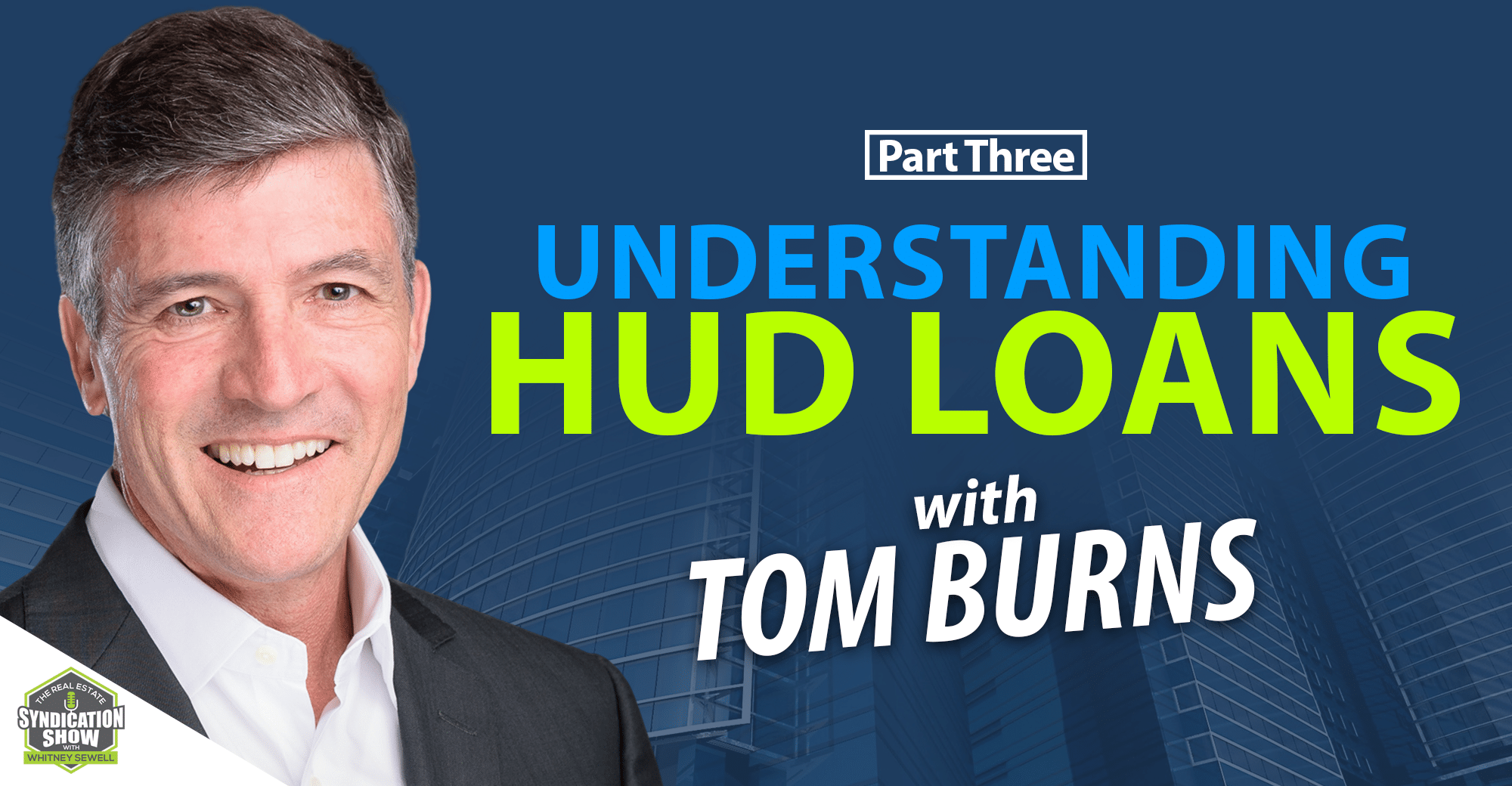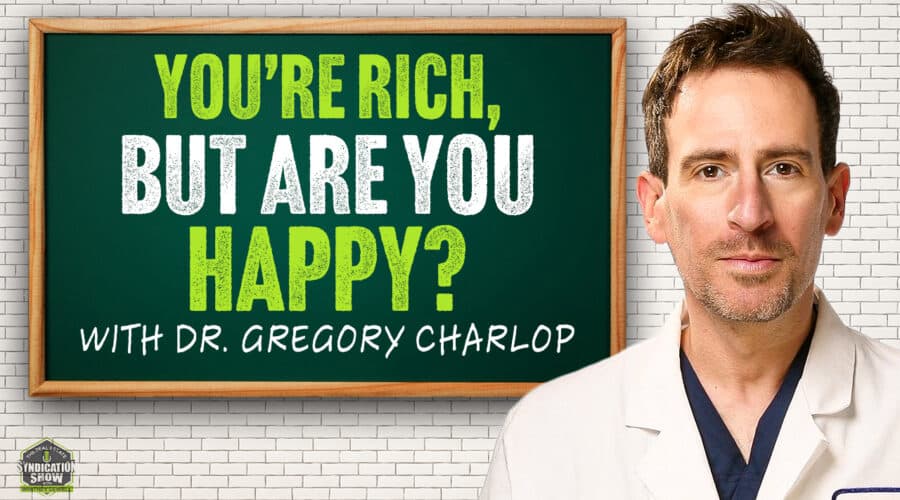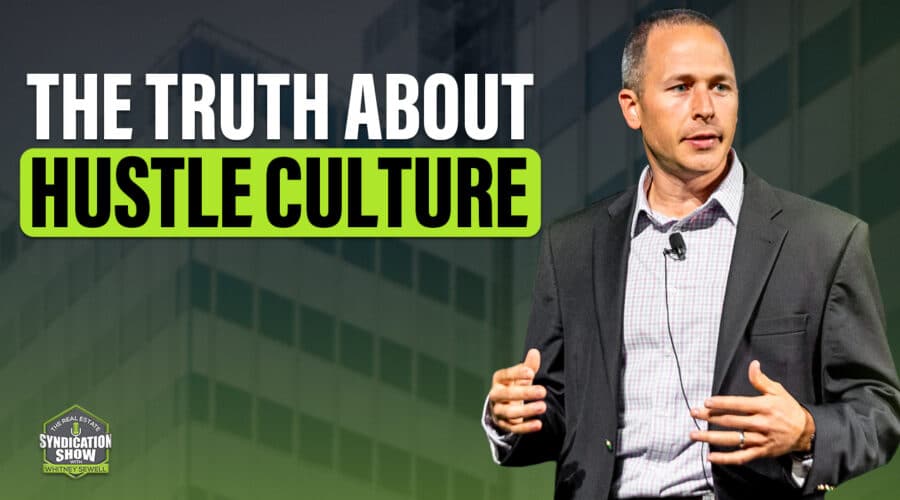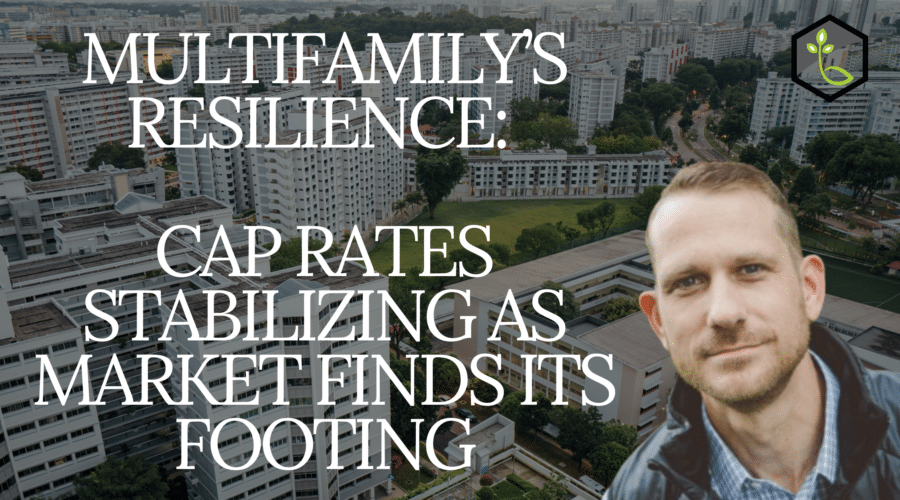
What is a Housing and Urban Development or HUD loan? How do you use them to move your multifamily deal forward? What are the pros and cons of it? Should you consider getting one? All these questions will be answered by our guest today, entrepreneur, retired orthopedic surgeon, and author, Tom Burns of Presario Venture.
Watch the episode here:
Listen to the podcast here:
In the last episode of our three-part series with Tom, he discusses what a HUD loan is, how long does it take to have one, how it can be assumable, as well as the considerations you need to have before getting it the first time. He also discusses how he is finding new investors right now by networking to a lot of people, the metrics he tracks personally and professionally, the how he gives back. Tune in now and learn about HUD loan today!
Key Points From This Episode:
- Tom defines what a HUD loan is.
- What are the benefits of getting a HUD loan specifically for multifamily?
- How long does it get to have your HUD loan approved?
- What to expect when getting a HUD loan?
- Tom says that most of class-A properties in the US were financed using a HUD loan.
- Tom elaborates how you can go from conventional to HUD loan.
- Tom shares that because of the current speed of the market, they started to utilize more insurance company and agency debt.
- Is HUD loan something you should be pushing from the start?
- What would have Tom do differently knowing what he knows now in the real estate space?
- Tom’s best source for meeting new investors right now.
- Tom talks about the challenge he is facing in his business.
- What are the most important metrics that Tom tracks?
- What’s the number one thing that contributed to Tom’s success?
- How does Tom like to give back?
Tweet This!
“These are agency backed loans, they are very long-term and they are fixed. So on the good side, if you develop a multifamily property and get a HUD loan, it’s 40 years of fixed rate interest, and 40-year amortization. And, if you go from 20, to 25, to 30, to 40, that type of amortization really increases cash flow.”
“It (HUD loan) takes time. There are multiple meetings and you have to invest significant money into your architecture, engineering, and civil, to get it to a point where HUD will actually officially give you the loan.”
“HUD will do their own research. They’ll make sure that we’ve got a feasibility study. They’ll make sure there’s a significant need for apartments in that area.”
“The more doors you have, the quicker your wealth and your cash flow will multiply.”
Links Mentioned:
WS1520: Prosperous Career Shift to Real Estate| Tom Burns
WS1521: Why Invest in Multifamily | Tom Burns
About Tom Burns

Tom Burns is an entrepreneur, retired orthopedic surgeon, and a physician for the United States Ski Team. He has over 25 years of real estate experience and has acquired or developed over $500 million of real estate locally and internationally. He is the co-founder and principal of Presario Ventures, a private real estate company focused on apartment development and private equity in Texas and the Sunbelt.
Dr. Burns is the author of Why Doctors Don’t Get Rich, a best-selling personal finance book for those who want to live life to the fullest. He is a sought-after speaker and mentor and has been financially independent for over a decade. He has created the Rich Life Mastermind to help people create financial independence so they can control their future and travel to exotic places
Full Transcript
EPISODE 1522
[INTRODUCTION]
Tom Burns (TB): These are agency-backed loans, they are very long-term and they are fixed. So on the good side, if you develop a multifamily property and get a HUD loan, it’s 40 years of fixed-rate interest and a 40-year amortization. And, if you go from 20 to 25, to 30, to 40, that type of amortization really increases cash flow.
Whitney Sewell (WS): This is your daily real estate syndication show. I’m your host, Whitney Sewell. We’re back with our guest, Tom Burns, an entrepreneur, and a retired orthopedic surgeon. He’s a physician from the United States ski team. He’s over 25 years of experience in real estate and developed over $500 million in real estate locally and internationally.
You’re gonna learn a lot from him again today, I hope you’ve listened to the last two days with him. But today, we’re gonna jump into HUD loans along with some personal stuff as well as helped him to grow. I enjoy that part of the show a lot and learning about people in just daily things that they do that have helped push them forward. And Tom is really big on that.
But first, you’re going to hear us talk about HUD loans, and that process, pros, cons, and how he has used them. But also, we’re gonna get into some habits that maybe you probably don’t expect Tom has, and how he is so focused on those daily consistent things and how he tracks them. I love that stuff. Because I know, it’s the small, consistent things that push the ball forward in such a big way. You’re gonna learn that from Tom today.
Don’t forget to like and subscribe to the show. I hope you are sharing it. I will be forever grateful for that. Have a blessed day.
[INTERVIEW]
WS: I appreciate the listeners being back with us again another day. And I’m grateful to be back with Tom Burns. Tom, welcome back to the show.
TB: Thanks, Whitney. Glad to be here as always.
WS: Yeah, honored to get to know you and have you as a guest and just your great degree of experience. And before I mentioned that, I want to encourage listeners to go back and listen to the last two days with Tom, we talked so much about passive investing and being a general partner and what you need to look for. Tom’s background while being a physician and getting into real estate and managing that. And so, I just encourage you to go back and listen the last few days so you can get to know Tom better and learn a lot.
And today, let’s dive in. Tom, I know you have used HUD loans a lot for multifamily. And I want to learn more about HUD loans. I want you to help the listeners and myself to learn more and just what that is, and maybe how you’ve used those and maybe you know what you’re using today, if that’s still the case, if it’s HUD loans. But let’s dive in there. What is a HUD loan? Maybe we can define that a little bit in the context of multifamily. And let’s jump in.
TB: You bet. So a HUD loan is FH and FHA HUD-insured loan. So, you’re not getting the loan from Housing and Urban Development, it’s being insured by them. The numbers may have changed. Last I checked, there were like 19 lenders across the country that would lend for HUD loans. So, these are agency-backed loans, they are very long-term and they are fixed. So on the good side, if you develop a multifamily property and get a HUD loan, it’s 40 years of fixed-rate interest and a 40-year amortization. And, you know, if you go from 20, to 25, to 30, to 40, you know, that type of amortization really increases cash flow.
And so, add to that if you develop under a HUD loan, you also get 20 months of interest only. So you get 20 months to build your property and lace it up, then you start advertising in month 21. And you’ve got 40 years after that. So that’s, that eliminates one of the variables in multifamily. You know, its interest rate, market and taxes, right, some of the things that affect multifamily, so we fix the interest rate. So they’re wonderful loans.
And they are very popular somewhat sometimes a few basis points less than some of the other agency loans, although Fannie Mae and Freddie Mac have gotten very aggressive these days, and they’re competing very well. Now, on the flip side, nothing’s free, right? No free lunch. It is sometimes very difficult to get out loan, it’s very time consuming very document heavy, takes a long time. So it might take you nine to 12 months these days to get a HUD loan for your development. It might take you six to nine to 12 months to do a HUD refinance.
So it takes time, there’s multiple meetings, and you have to, at some point, you have to invest significant money into your architecture, engineering, and civil to get it to a point where HUD will actually officially give you the loan. Now, as you begin more experienced, you’ll know that once you start spending that money, you’ll you’ll have a 95 or more percent chance that you’ll get the loan. But, when you’re spending $800,000 to a million dollars to hopefully get the loan, it’s nice to get it.
So, another downside, or just difference is that if you’re invested in a property that has a HUD loan, they can only distribute every six months. But the good news is is that your sponsor whoever he or they are, they have to get a third party on it. So there’s always a Big Brother looking over the sponsors shoulder and I think that’s be a source of comfort for the investors because they’re making sure the numbers are right HUDs looking at him everything’s speaking Spanish shined up and then whatever excess surplus cash there is we distribute.
So, if you look, just to wrap up, if you look, I remember I had a business partner, I say “I have got this development project, we got a HUD loan and all this.” And he said, “Well,” he said, “I would never invest in a property that I wouldn’t live in myself.” And said, “Well, that’s not what this is.” Point being that people think that HUD means affordable tax credits, section A, nice property. I’ll tell you a lot of the beautiful Class-A apartments that you drive past wherever you are in the country are financed with a HUD loan. So it’s a good product, it just, you know, has some give and take to it.
WS: Yeah, would you say mostly for developments or any pre-existing type financing?
TB: In the multifamily world, you can get up to 221 D4 as your development loan, and you can get a 223 F, which is a refinance loan. And so, you can build it with a 221 D4, then later on you refinance to 223 F, or you can buy a value-add property with a bridge loan, and improve maybe 10% of the property and prove up the increased rents. You can then use that 10% to amortize over the entire property. And HUD will start the process to do 223 F cash out refinance, if you wish.
So, you can go from conventional to HUD, with existing property as well. It’s a nice process. Again, it’s involved, but you’ll get sometimes 30 to 35 years of amortization on that cash out refinance.
WS: I know you mentioned six to nine months just for the approval process, $800k to a million possibly spent, is it possible spend that 100k or a million and not get approved?
TB: It’s possible but pretty much unlikely. You know, they’ll tell you and usually to get a HUD loan, or at least in the past, they want you to be somewhat experience. You know, what’s the deal, you can’t get experience without a job, you can’t get a job without experience. They do let new people in and they let us in new people, but they’ll give you indications, “Hey, we really liked this, this is great.”
Because HUD will do their own research. They’ll make sure that we’ve got a feasibility study. They’ll make sure there’s a significant need for apartments in that area. And so, you’ve pretty much got a good idea, if you spend about 100 grand, you go to these various meetings, there’s first a concept meeting, we’d like to build apartments here. They’re like, “Okay, that looks pretty good. We like it. Do your thing.” You spent about 100 grand getting some drawings, concepts, you bring them in, and if they give you a kind of a go forward letter, you pretty much know you’re gonna get it, something bad has to happen. So you can be comfortable spending that money.
And, if you spend all that money, and HUD doesn’t give you a loan, you can still go get another loan. It’s all money that you got to spend anyway, it’s architecture, civil engineering, that sort of stuff permits fees. So, it’s all the stuff you’d spend if you were just borrowing from a bank or insurance company.
WS: Yeah, that’s the point that I was hoping or we would make there, you would make it that I’m glad you did. It’s like, well, it’s money that you’re gonna have to spend anyway for all those studies and stuff you want to know or you’re going to need to know or have to know as you go to get debt from some source one way or the other. What about, is HUD loan something you are still using right now? Or when would you use them right now? Or versus what are the types of debt?
TB: We do still use it I have transparently over the last three or four years with the speed of the market, you know, everybody, things just were crazy. We started utilizing more insurance company, an agency debt for some of our construction, mostly actually bank and insurance company for construction projects.
Still, we do have, because and particularly now, you got a fixed rate loan right now, it becomes valuable because interest rates are rising, right? Now, as a rise if you can go buy a HUD loan. Another good thing about HUD loans, they’re assumable. So somebody said that, you know, 3, 8, 5 interest rate still has 38 years left on their loan, you think, “Wow, what a great deal.” Well, it’s a great interest rate, you’re still going to pay the equity gap between what HUD requires and what the property’s worth.
So, you’re gonna pay a lot of equity for it but then you’ll at least have a fixed interest rate. But, we’re still using it or not necessarily initiating it on developments. We’ll jump in and take over a HUD loan either a pre-stabilization or property. That’s a good yield to. We’ll jump in because we’re good buyers, good borrowers and HUD’s eyes. So, it’s pretty easy to get us approved. So, we look at those. Look at those.
WS: That’s awesome. Would you recommend it, you mentioned that people can get started if you gotta get started somehow, right? And it’s hard, sometimes there’s no experience, but as people are getting started as operators, is HUD something they should be pushing towards from the beginning?
TB: Yeah, I’d tell you, probably not as the first one. I mean, there’s a lot of brain damage getting a HUD deal. A lot of brain damage. And, it’s more expensive to get. They require a lot more stuff. If you were to do that, I would get with somebody that’s very expounded partner with somebody that’s very experienced and you can learn along the way. If it’s just you and your partner maybe you do not have a lot experience, I would go a more conventional route. I’d looked at banks, insurance companies, maybe Fannie Mae, Freddie Mac,
WS: Yeah. No, that’s awesome. I want to shift gears just a little bit with the last few minutes that we have together. Tom, I wanted to ask you too from your experience, and as a physician and moving into real estate, like we talked about in the first first segment, what would you do different if you could talk to Tom 30 years ago, what would you tell him?
TB: Yeah, I always answer that question. I wouldn’t change anything, because it’s brought me to where I am. And I’m very happy with my life and blessed with where I’ve ended up. You know, of course, we have ups and downs. B
But, my focus a little more, I’m like the poster child for attention deficit. I’ve done so many different things. And, it’s all kind of ended up coming back to real estate, and particularly multifamily. And, I would probably do more. I was slow, deliberate, and consistent, which is a great way to go. But I would probably be, I would probably have been just a little bit more aggressive that, you know, if one thing worked, I would probably try to multiply that and do it again because become more of an expert. And it really multiplies your efforts.
And, the more doors you have, the quicker your wealth and your cash flow will multiply. And finally, I’d probably, I kno, I got a mentor early. I would have. And I’ve had, I’ve got lots of them. Now, I would have used everything I had to, I would have beg, borrow, and steal for people to just teach me what they know. Even though I did some of that I would have done more of it.
WS: Love that right there. You got to beg, borrow, and steal, to learn more, to gain more education early on, right?
TB: Practical knowledge from somebody who’s been there, that would it have been worth millions compounded over 20 or 30 years.
WS: Very wise, right there. What about what’s your best source for meeting new investors right now or growing your investor base?
TB: It’s usually networking, not contrived networking, but it’s just getting out there and being with other people. So that’s usually the best source. I put out a blog, newsletter, whatever you want to call it, people tend to, you know, sometimes new people find that and they’ll find their way to Presario or to some of the deals that I do separately. So I’m not a big social media kind of guy,I’m not ever going to send you a picture of my food.
WS: Thank you. Thank you.
TB: And you know, I’m not an avid poster. I probably posts maybe two or three times a year. So, I’m sure a lot of people would say you could do a lot better Tom. But, I try to put out good content, people come in through those venues. A lot of times people come through podcasts like this.
So, it’s funny without out there trying to get new investors, which we are in my company, we put out stuff to try, you know, we make it easy for investors to find us. But the rest of it just kind of happens as a byproduct of me trying to learn and me trying to help other people learn how to get what they want. So it kind of works out, everybody wins in the end.
WS: What about a challenge you’re facing in your business right now?
TB: Oh, gosh, depends on which business. And, probably in the multifamily world, it’s really the development because you got to look two or three years out. And so, if we can’t get a g max contract, which means our construction prices are fixed, and the contractor has responsibility for the prices, we’ve got to be really careful. So, the challenge is making sure that we can somewhat predict where the world is going to be in two years, to make sure that we have a viable product when it goes from a piece of dirt to a, you know, full vertical and leased up the property. So it’s difficult right now for us to find deals that we feel good enough that fit our parameters. We’re still finding them and it’s just difficult. So we’re working harder.
WS: Awesome. No doubt, it’s difficult. What are some of the most important metrics that you track? It could be something personal, it could be how many times you get out of bed on time, or it could be how many deals you’re underwriting or your benchpress number or you know, either way, what are some of the most important metrics to Tom?
TB: Okay, yeah. Tom metrics. I have a journal that I write in, supposedly each morning. I can tell you, I’ve missed a lot of mornings this year. But, I have a journal that I write in and in the back, I have a habit tracker. And I give that to the folks in my mastermind. I stole that, of course, from atomic habits. James Claire’s book, which is a fabulous book, but I track habits.
And so, I track I try to do 100 push ups a day. I track those. I like to take hikes because that’s where my mind clears. And that’s how I wrote half my book is when that’s my meditation. I’m a poor meditator ping pong balls bounce around my head. So I track and track my hikes because that’s where my mind clears.
You know, I track how many books I read how many days I’m reading the amount of time that I fast I like I prefer to do intermittent fasting as a habit. So a lot of its health these days, and a few business things. You know, the number of times I speak the number of times I’m on a podcast, it’s just I don’t actively go out looking for those things. But I want to know the numbers.
WS: Yeah, that’s awesome. If you don’t track it, you don’t know right? And you can’t improve exactly if you’re not tracking and so I love those things that you listed there, even that many of them were personal things too, like that, which I think flows right into your business, right. Getting those push-ups and or getting those hikes in or reading all that, man, just affects your business in a big way.
TB: And you have to be healthy. If you feel healthy, feel good, you have more energy. The other thing I’m tracking is tennis. I took up tennis again after 30 years. And so, I track how many days I play tennis just to see if I’m putting my feet where my mouth is, but it’s filled up pretty good.
WS: That’s awesome. Any other habits that have helped produce a high return for you that you’d like to highlight?
TB: That’s really that habit of persistence, occasionally, certainly some delayed gratification, but that’s why I preferred daily habits as opposed to massive action. It’s awesome to standard Tony Robbins thing and move your hands up and down. But I prefer daily small habits because they compound so that’s it, it’s it’s habit.
For me, it’s just habit and persistence and actually doing something every day. You know, my my core values are the adventure, connection, growth, and that growth thing is I want to do something every day makes me a little better Tom today than I was yesterday, either physically, personally, spiritually, family-wise, or in my business. That seems to work for me.
WS: I love that as well, getting better every day, if you’re 1% better every day, right? Do the math. It’s so what’s the number one thing that you would say is contributed to your success?
TB: I think the people around me,.I take no credit for what I’ve done, all I did was try to you know, keep my knees high. And I’m I head down each day and do some work. But I’ve had, I’ve had so many good people that have helped me taught me partnered with me, I love people. And I love hanging around with those folks. And I prefer to do things in partnership than as the Lone Ranger. So I think my network, my partners, my friends, that’s the greatest wealth and my treasure chest. I think that’s what’s made me wealthy and given me a life that, that I’m enjoying.
WS: Yeah, that’s awesome. What about how do you like to give back?
TB: I give a lot of my time for free. You know, a lot of people, you know, have a paid mastermind, but you know, that fails to the number of people I talked to that call and just want to have, you know, just want to have some advice. And so, I like to do that I like to teach and then provide my time and my money to certain causes, you know, foster children and those that are in people that are afflicted with any type of substance abuse, right, because that really affects it doesn’t affect them, it affects their family, which affects the world.
WS: Yeah. Wow. Well, Tom, grateful and thankful for you to just wait, you’ve given back to us today, the listeners and myself just going through HUD loans, what they are and how you’ve used them, or the pros and the cons, which you listed many, which I think we should all consider as we’re thinking about that. And it could help us in so many ways, however, also getting into the more personal side of Tom, you know, even the habits and the journaling to what you’re tracking, I think it’s helpful to like practically for the listeners, even as you’re starting to think about journaling, and I’ve done it on and off for a number of years. And it’s always been beneficial.
Sometimes, like kicking myself sometimes right? It was like, Why did I not do it for that six months or a year? You know, it’s like, I know, it’s beneficial. And so, you know, just encourage the listener as well to take Tom’s advice and think about those things that are pushing you forward. And how you said to you prefer daily habits over massive action. It’s so true, right? The consistent things right, whether they may seem small at the time, but man six months later, some a lot. It’s happened, right, you’ve moved a long way.
Tom, I was so grateful to meet you and have you on the show the listeners again, how they can get in touch with you and learn more about you.
TB: You bet if you go to rich dot life forward slash toolkit that’ll take you to the website. It’ll also get you some free gifts that’ll maybe help you work on your real estate portfolio and stuff that’s helped me over the past 30 years. So looking forward to talking to you sometime in the future.
[END OF INTERVIEW]
[OUTRO]
Whitney Sewell: Thank you for being with us again today, I hope that you have learned a lot from the show. Don’t forget to like and subscribe. I hope you’re telling your friends about The Real Estate Syndication Show and how they can also build wealth in real estate. You can also go to LifeBridgeCapital.com and start investing today.
[END]
Love the show? Subscribe, rate, review, and share!
Join the Real Estate Syndication Show Community:




